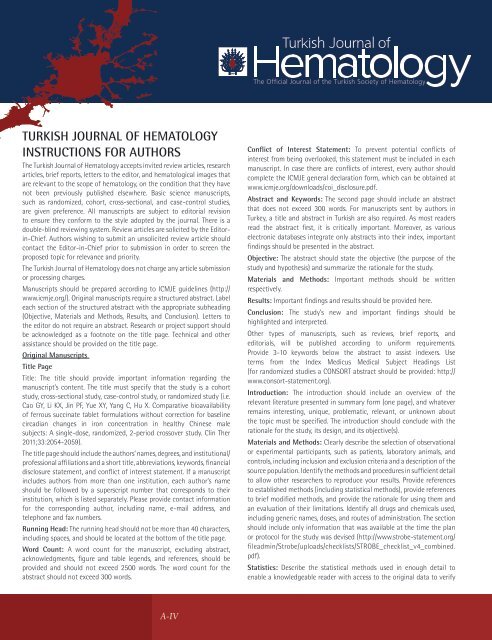Turkish Journal of Hematology Volume: 34 - Issue: 1
Create successful ePaper yourself
Turn your PDF publications into a flip-book with our unique Google optimized e-Paper software.
TURKISH JOURNAL OF HEMATOLOGY<br />
INSTRUCTIONS FOR AUTHORS<br />
The <strong>Turkish</strong> <strong>Journal</strong> <strong>of</strong> <strong>Hematology</strong> accepts invited review articles, research<br />
articles, brief reports, letters to the editor, and hematological images that<br />
are relevant to the scope <strong>of</strong> hematology, on the condition that they have<br />
not been previously published elsewhere. Basic science manuscripts,<br />
such as randomized, cohort, cross-sectional, and case-control studies,<br />
are given preference. All manuscripts are subject to editorial revision<br />
to ensure they conform to the style adopted by the journal. There is a<br />
double-blind reviewing system. Review articles are solicited by the Editorin-Chief.<br />
Authors wishing to submit an unsolicited review article should<br />
contact the Editor-in-Chief prior to submission in order to screen the<br />
proposed topic for relevance and priority.<br />
The <strong>Turkish</strong> <strong>Journal</strong> <strong>of</strong> <strong>Hematology</strong> does not charge any article submission<br />
or processing charges.<br />
Manuscripts should be prepared according to ICMJE guidelines (http://<br />
www.icmje.org/). Original manuscripts require a structured abstract. Label<br />
each section <strong>of</strong> the structured abstract with the appropriate subheading<br />
(Objective, Materials and Methods, Results, and Conclusion). Letters to<br />
the editor do not require an abstract. Research or project support should<br />
be acknowledged as a footnote on the title page. Technical and other<br />
assistance should be provided on the title page.<br />
Original Manuscripts<br />
Title Page<br />
Title: The title should provide important information regarding the<br />
manuscript’s content. The title must specify that the study is a cohort<br />
study, cross-sectional study, case-control study, or randomized study (i.e.<br />
Cao GY, Li KX, Jin PF, Yue XY, Yang C, Hu X. Comparative bioavailability<br />
<strong>of</strong> ferrous succinate tablet formulations without correction for baseline<br />
circadian changes in iron concentration in healthy Chinese male<br />
subjects: A single-dose, randomized, 2-period crossover study. Clin Ther<br />
2011;33:2054-2059).<br />
The title page should include the authors’ names, degrees, and institutional/<br />
pr<strong>of</strong>essional affiliations and a short title, abbreviations, keywords, financial<br />
disclosure statement, and conflict <strong>of</strong> interest statement. If a manuscript<br />
includes authors from more than one institution, each author’s name<br />
should be followed by a superscript number that corresponds to their<br />
institution, which is listed separately. Please provide contact information<br />
for the corresponding author, including name, e-mail address, and<br />
telephone and fax numbers.<br />
Running Head: The running head should not be more than 40 characters,<br />
including spaces, and should be located at the bottom <strong>of</strong> the title page.<br />
Word Count: A word count for the manuscript, excluding abstract,<br />
acknowledgments, figure and table legends, and references, should be<br />
provided and should not exceed 2500 words. The word count for the<br />
abstract should not exceed 300 words.<br />
Conflict <strong>of</strong> Interest Statement: To prevent potential conflicts <strong>of</strong><br />
interest from being overlooked, this statement must be included in each<br />
manuscript. In case there are conflicts <strong>of</strong> interest, every author should<br />
complete the ICMJE general declaration form, which can be obtained at<br />
www.icmje.org/downloads/coi_disclosure.pdf.<br />
Abstract and Keywords: The second page should include an abstract<br />
that does not exceed 300 words. For manuscripts sent by authors in<br />
Turkey, a title and abstract in <strong>Turkish</strong> are also required. As most readers<br />
read the abstract first, it is critically important. Moreover, as various<br />
electronic databases integrate only abstracts into their index, important<br />
findings should be presented in the abstract.<br />
Objective: The abstract should state the objective (the purpose <strong>of</strong> the<br />
study and hypothesis) and summarize the rationale for the study.<br />
Materials and Methods: Important methods should be written<br />
respectively.<br />
Results: Important findings and results should be provided here.<br />
Conclusion: The study’s new and important findings should be<br />
highlighted and interpreted.<br />
Other types <strong>of</strong> manuscripts, such as reviews, brief reports, and<br />
editorials, will be published according to uniform requirements.<br />
Provide 3-10 keywords below the abstract to assist indexers. Use<br />
terms from the Index Medicus Medical Subject Headings List<br />
(for randomized studies a CONSORT abstract should be provided: http://<br />
www.consort-statement.org).<br />
Introduction: The introduction should include an overview <strong>of</strong> the<br />
relevant literature presented in summary form (one page), and whatever<br />
remains interesting, unique, problematic, relevant, or unknown about<br />
the topic must be specified. The introduction should conclude with the<br />
rationale for the study, its design, and its objective(s).<br />
Materials and Methods: Clearly describe the selection <strong>of</strong> observational<br />
or experimental participants, such as patients, laboratory animals, and<br />
controls, including inclusion and exclusion criteria and a description <strong>of</strong> the<br />
source population. Identify the methods and procedures in sufficient detail<br />
to allow other researchers to reproduce your results. Provide references<br />
to established methods (including statistical methods), provide references<br />
to brief modified methods, and provide the rationale for using them and<br />
an evaluation <strong>of</strong> their limitations. Identify all drugs and chemicals used,<br />
including generic names, doses, and routes <strong>of</strong> administration. The section<br />
should include only information that was available at the time the plan<br />
or protocol for the study was devised (http://www.strobe-statement.org/<br />
fileadmin/Strobe/uploads/checklists/STROBE_checklist_v4_combined.<br />
pdf).<br />
Statistics: Describe the statistical methods used in enough detail to<br />
enable a knowledgeable reader with access to the original data to verify<br />
A-IV

















